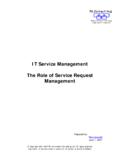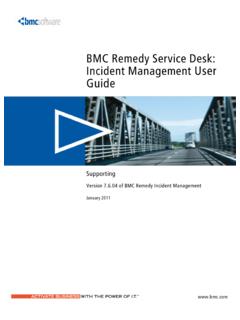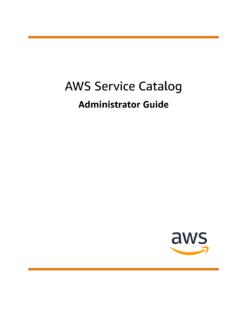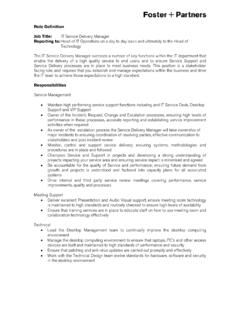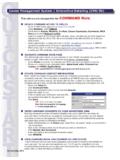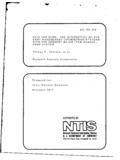Transcription of Understanding itiL service portfolio Management …
1 Best practices WHite paperUnderstanding itil service portfolio Management and the service catalogAn approach for implementing effective service lifecycle managementtable of contents Executive Summary ..1 service portfolio Management According to itil ..2 service Lifecycle Management > ..2 Business service Management > ..2 The service portfolio as a Strategic Asset ..3 service portfolio Pipeline > ..3 service Catalog > ..4 Retired services > ..4A Closer Look at the service Catalog ..4 Structure > ..4 The Role of the Configuration Management System and Configuration Management Database > .. 5 Enabling service -Oriented Architecture Applications >.
2 5 Implementing and Leveraging the service portfolio ..6 Gaining Control of Development Projects > ..6 Automating service request Management > ..6 Extending Beyond IT services > ..6 Conclusion ..7 PAGE > 1executive summaryImagine trying to run a manufacturing business without a comprehensive, detailed view of the products provided by your company. It would be difficult to know all the products currently planned, in develop-ment, or available to customers. You wouldn t know the recurring or nonrecurring product costs, the prices, or the sources of products and component assemblies. How could you even determine the support resources required for each product or the product s warranty options?
3 Manufacturing firms learned long ago about the importance of maintaining comprehensive and accurate documentation on their product lines. Such information provides the foundation for informed decision executives and their teams face a similar need to have a comprehensive and accurate view of IT services . Without this view, it s difficult, if not impossible, to run IT as a business. To be successful, take a lesson from manufacturing firms and create comprehensive and accurate documentation of your products, including planned and existing services . The result is a service catalog that includes all relevant details about each service , including which service level agreements (SLAs) are associated with it, who is able to request it, how much it costs, and how to fulfill can leverage this information to gain full control of your service portfolio through effective service portfolio Management .
4 This approach helps you focus on your priorities to improve the services that support the business. It allows for the most efficient use of IT resources, which reduces costs and helps increase business agility and user satisfaction. Ultimately, service portfolio Management sets up a process for the business to generate greater value. This paper describes the IT Infrastructure Library ( itil ) Version 3 (V3) approach to service portfolio Management . It examines the various components of the service portfolio , such as the service catalog. In addition, it discusses technologies available to develop and manage the service portfolio and to leverage the information contained in the > 2service portfolio Management according to itiLITIL stresses the importance of effectively managing the entire lifecycle of every service from request to retirement.
5 This requires a disciplined approach to the following:Performing a strategic assessment of the benefits and >potential value generation of the IT servicesEvaluating requests for new services or for enhancements >to current servicesPlanning and developing new and enhanced services for >requests that have been approvedDeploying new and enhanced services into operation with >minimal riskEffectively managing and supporting operational services >Continually evaluating services and searching for areas >of improvementRetiring services that no longer have business value >Many IT organizations are already addressing the manage-ment of deployed services
6 By using available service Management tools and solutions. These tools enable IT to maintain service delivery at agreed-upon levels and provide effective support. Solutions are also available that enable IT to understand the relationships of the services to the underlying technology components that support them, as well as the business priorities of the services . service Lifecycle ManagementIT organizations are looking at ways to gain better control of services by addressing the Management of the full service lifecycle. itil V3 provides an approach for implementing effective ser-vice lifecycle Management service portfolio Management .
7 As defined in Section of the itil V3 service Strategy book1 and illustrated in Figure 1, service portfolio manage-ment consists of four major steps:Define >. Collect information and inventories of existing services . Establish the requirements for the requested service , and establish the business case for implementing the >. Review the long-term business goals, and deter-mine what services are required to meet those goals. Then analyze the requested service for financial viability, operational capability, and technical feasibility to determine how the organization is going to get there. (You may decide to obtain the service from an outsourcer rather than develop it internally.)
8 Approve >. Make a decision to retain, replace, renew, or retire the services . Charter >. Communicate action items to the organization to implement approved service , and allocate budget and 1. service portfolio Management The define, analyze, and approve steps are described in the itil V3 service Strategy book. The charter step is discussed in the itil V3 service Design service ManagementThe service portfolio Management process requires continual re-evaluation and refreshing of services to adapt to changing business conditions. This can be accomplished through more rigorous planning and analysis based on comprehensive business information, such as leveraging top-down Business service Management (BSM) analysis.
9 BSM is an approach for managing IT from the perspective of the business. By following this approach, you can make better decisions about which services to develop, deploy, and retain. The process helps you make more effective decisions based on business factors such as cost and expected value to the business as well as on technical feasibility. With a view of your service portfolio , you can readily identify other services that provide the same or similar functions as a requested service to avoid duplicating service portfolio Management helps you make better-informed, make-or-buy decisions, such as whether to outsource.
10 You can determine the actions to take related to pricing services because you ll have accurate cost information. This approach also helps you determine which services to run as usual and which to transform into new services as determined by business needs and your ability to expand your offerings. Finally, it lets you retire a service that does not meet minimum technical and functional objectives. As a result, you ll improve your service offering by focusing on services that deliver the most value to the business. PAGE > 3In a mature IT organization, the most complex task of an IT executive is to integrate IT goals and objectives with overall business goals and value drivers.

